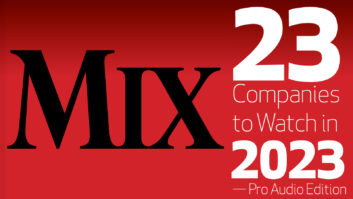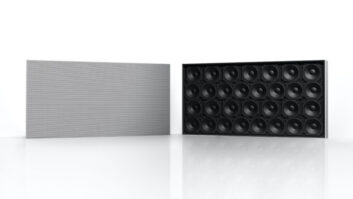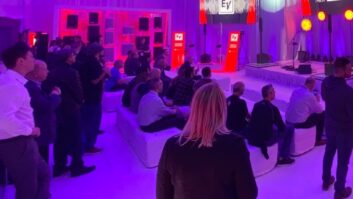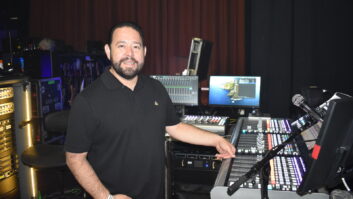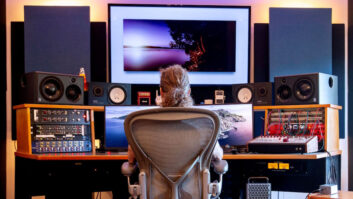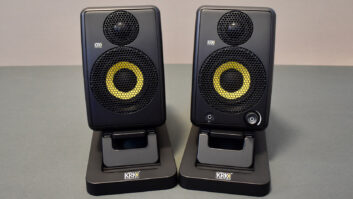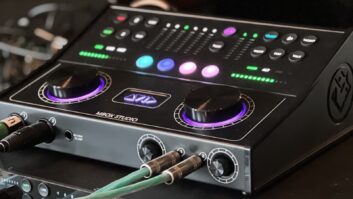Montreal’s Simple Plan just finished its fourth studio album, due to hit record store shelves and online outlets next month. The band took more than two years to complete the new project, which was recorded in equal parts at Montreal’s Planet Studios and Vancouver’s Van Howes Studio—home base for Canadian producer Brian Howes. Working alongside Howes and engineer Jay Van Poederooyen, Simple Plan started the project with 60 song demos, ultimately whittling the list down to roughly a dozen songs, which it brought into the studio to record. Pro Sound News spoke to lead guitarist Jeff Stinco, who explained why this project was different from previous Simple Plan recordings.
On Choosing Songs :
For this album, we wrote 60 songs, and this was the first time we approached a record as if we were doing singles. So we focused on every single song and finished it before moving on to the next song. This isn’t an efficient way of doing a record, because you have to set up again after every song; but it pushes you to go after your best performance. This way of working was interesting and a lot of fun, but tedious.
After we demoed the 60 songs, it was a question of voting on which ones we would record. You want to try different things and go in different directions, but you want a collection of songs that have a common thread. In our band, there are five strong personalities, and certain band members get attached to certain songs. For the core of the record though, we definitely agreed on which ones to record.
On Combining Influences :
We’ve always had great engineers and producers working with us. For example, we’ve worked with Bob Rock and Don Gilmore. But on this record, we’ve kind of integrated all of our influences a little bit better. Our first record was a fun, rocking record; the second record was a little more polished and a continuation of that. The third record was our take on a more electronic sound. This record takes all that we’ve done and combines all our influences. It works out really well, and there is a lot of variation. Sonically, it goes into a lot of different directions; the mixes were energetic and fun.
Brian [Howes] has been in bands before and was, in fact, quite successful with Hinder and other bands. To him, it was just about making the songs as good as possible. We’ve been doing this for a long time also, so we needed someone who would trust us and let us try things, which he did. There was a mutual respect on both sides and that was great.
On Tracking and Microphones :
We tracked the bed tracks on a Neve, and the overdubs and vocals were done on an SSL. There was no preconceived formula—we went by ear and tried new things. As far as microphones are concerned, we used a Neumann U87 on vocals, and it worked really well. On guitars, we used some Shure SM57s, Royer 121s and Sennheiser 421s through a handwired Vox AC30 amp. I like the 421 for both for clean and dirty sounds.
It can be somewhat stressful in a commercial studio because you’re always watching that red light go on. But in Van Howes Studio in Vancouver, it was really easygoing. You didn’t have overwhelming walls and walls of gear, but you did have all the great gear that you needed to make a record. As a producer, Brian was very relaxed and confident enough to say, ‘You go and do your thing.’ We appreciated that. Our singer definitely got his best vocal track on this record, and it was all because he was given the freedom to try new things. A lot of the times, Brian uses humor to get the best track out of you.
On the Producer as Referee :
Producers are a lot like product managers— they have to deliver a CD to a label on time and in budget. And they have to make sure that all the songs work and that there is a concise record coming out of it. In the end, Brian was also the referee: If we didn’t agree, he had the veto right. We gave him that right, because we knew someone has to decide. Otherwise, we couldn’t move forward.
On the first record, our band would fight over ideas, to the point of where it would become physical. Now we are all more confident and trust each other a little more; this has ultimately allowed some better ideas to appear on this record. Also, since the songs are more varied than they were before, I can pull in ideas that wouldn’t have worked in the past. You have more latitude to bring your influences to the table.
On Stand out Tracks :
There is one song called, “Jet Lag,” which is a duet with Pierre [Bouvier, lead vocalist] and Natasha Bedingfield. We always wanted to have a duet with a female singer, but we never found exactly the right person to do it with. “Jet Lag” is a great rock song with a lot of production ideas. In fact, it’s kind of heavy on the guitars for a pop song. It brought a new sound to what we were doing, and I think it’s going to surprise a lot of people.
Another song I like is called “Astronaut.” This song is more introspective, and it’s about being alienated and alone. Sonically, as soon as you hear the acoustic guitars and piano, you’re in that bubble and it’s kind of eerie. It sounds spacey, and Pierre’s vocal performance is really insane. There is very intimate proximity, and it feels like he’s right next to you.
Jeff Touzeau is a regular contributor to Pro Sound News, and author of the recent title, Sound Ideas for a Sound Planet: The Green Musicians Guide (Cengage).

